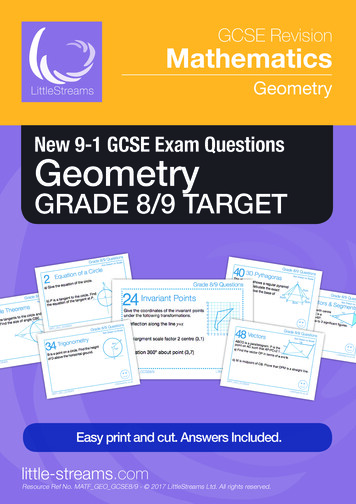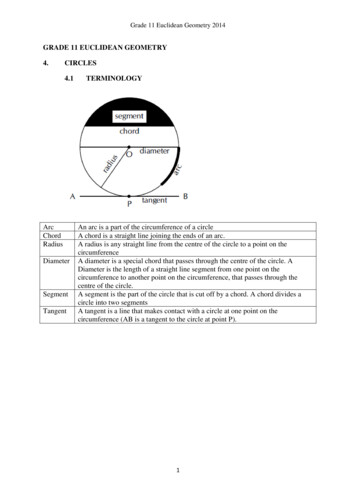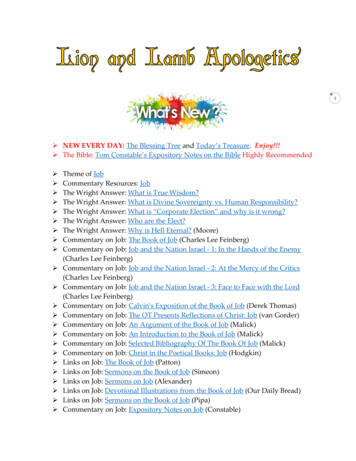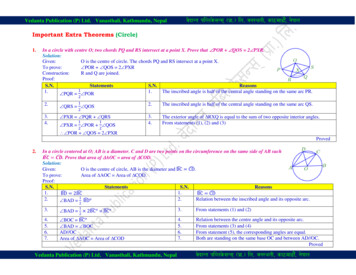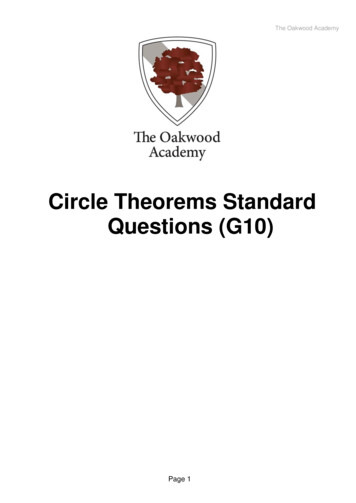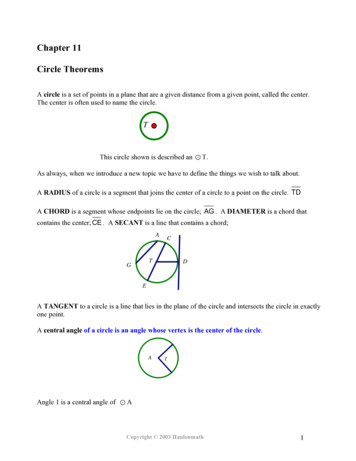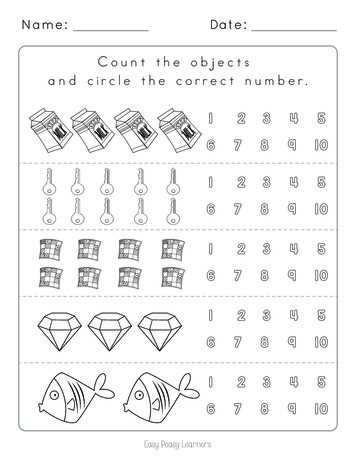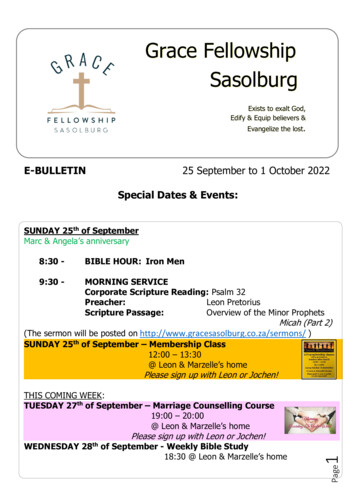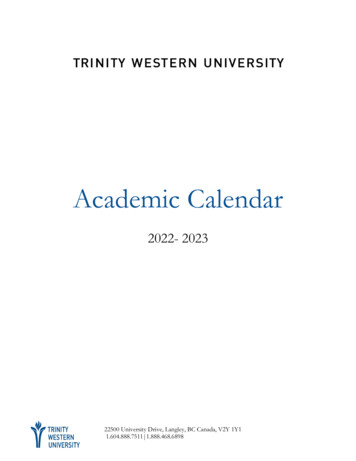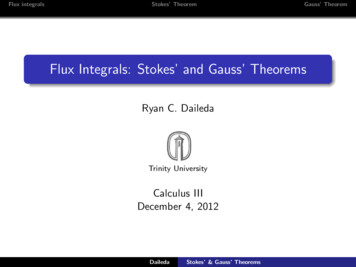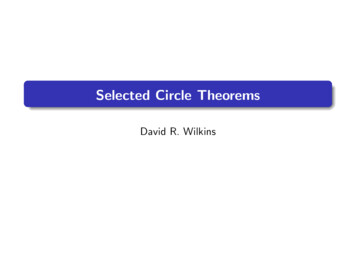
Transcription
Selected Circle TheoremsDavid R. Wilkins
4. Selected Circle Theorems (continued)Lemma 4.1 (Elements, III-2)Let A and B be distinct points on a circle. Then all points on thechord [AB] between A and B lie inside the circle.ProofLet C be the centre of the circle. Then the sides [CA] and [CB] ofthe triangle 4CAB are equal. It follows from the Isosceles TriangleTheorem (Elements, i, 5) (PPG, Theorem 2) that the angles CAB and CBA are equal.
4. Selected Circle Theorems (continued)Let D be a point on the chord between A and B. Then the exteriorangle CDB of the triangle 4CADis greater than the opposite interiorangle CAD (Elements, i, 16) (PPG,Theorem 6), and thus is greater than CBD. If follows that, in the triangle 4CDB, the side [CB] opposite thegreater angle CDB is greater thanthe side [CD] opposite the lesser angle CBD. (Elements, i, 19). Thusthe line segment [CD] has length lessthan the radius of the circle. The result follows.CBAD
4. Selected Circle Theorems (continued)Proposition 4.2 (Elements, I-12 and III-3)Let A be a point, let BC be a line that does not pass through thepoint A, let a circle with centre A cut the line BC at points E andF , and let the point D bisect the line segment [EF ]. Then ADEis a right angle.ABEDFC
4. Selected Circle Theorems (continued)ProofJoin the centre A of the circle to points E and F . Then AE AF and ED FD . It follows from the SSSCongruence Rule (Elements, i, 8) that the triangles 4ADE and4ADF are congruent. It follows that the angles ADE and ADF are equal, and therefore ADE is a right angle.ABEDFC
4. Selected Circle Theorems (continued)Corollary 4.3 (Elements, III-1)Given distinct points B and C on the circumference of a circle, thecentre of the circle lies on the perpendicular bisector of the linesegment [BC ].FABDEC
4. Selected Circle Theorems (continued)FThe figure to the right represents themethod of locating the centre A ofa circle set out in Proposition 1 ofBook III of Euclid’s Elements of Geometry. Given two distinct points Band C on the circle, the perpendicularbisector is constructed. This perpendicular bisector intersects the circle intwo points, and the point lying midway between those two points is thecentre A of the circle.ABDEC
4. Selected Circle Theorems (continued)The figure to the right represents themethod of locating the centre A of acircle implicit in the proof of Proposition 10 of Book III of Euclid’s Elements of Geometry. Given three distinct points B, C and D on the circumference of the circle, the perpendicular bisectors of the chords [BC ]and [CD] are constructed. The pointwhere those perpendicular bisectorsintersect is the centre A of the circle.DABC
4. Selected Circle Theorems (continued)Lemma 4.4 (Elements, III-3)Let A be the centre of a circle, and B and C be distinct points onthe circumference of the circle, and let D be a point on the chord[BC ] joining the points B and C . Then D bisects [BC ] if and onlyif [AD] is perpendicular to [BC ].ProofIt follows from Proposition 4.2 that if D bisects [BC ] then [AD] isperpendicular to [BC ]. We must prove the converse.
4. Selected Circle Theorems (continued)Suppose therefore the [AB] is perpendicular to [BC ]. Now 4BAC is anisosceles triangle. It follows from theIsosceles Triangle Theorem that theangles ABC and ACB are equal.Thus the angles of the triangle 4ABDat A and B are equal to the anglesof the triangle 4ACD at A and C .The angles of these two triangles atA must therefore be equal, becausethe angles of a triangle add up to tworight angles. It then follows from theASA Congruence Rule that the triangles 4ABD and 4ACD are congruence, and therefore D bisects [AC ].This completes the proof.ABDC
4. Selected Circle Theorems (continued)Proposition 4.5Let A be a point, let l be a line that does not pass through thepoint A, and let D be the point on the line l for which [AD] isperpendicular to l. Then the line segment joining the point A toany point of the line l distinct from D is greater than [AD].AlDE
4. Selected Circle Theorems (continued)ProofThe sum of two angles of a triangle is less than two right angles.Therefore all angles of a right-angled triangle other than the rightangle itself must be acute. Let E be a point of the line l distinctfrom D. Then the angle AED must be acute. It follows that theside [AE ] of the triangle 4ADE opposite the right angle at Dmust be longer than the side [AD] opposite the acute angle at E .The result follows.
4. Selected Circle Theorems (continued)A line passing through a point on the circumference of a circle is atangent line of the circle, and is said to touch the circle, if and onlyif it does not pass through any point in the interior of the circle.Proposition 4.6 (Elements, III-16)Let A be a point on the circumference of a circle with centre B.Then a line through the point A is tangent to the circle if and onlyif the line is perpendicular to the line AB joining A to the centre ofthe circle.ProofIt follows from Proposition 4.5 that if a line through A isperpendicular to AB then A is the closest point on that line to thecentre of the circle, and therefore the line does not pass throughany point in the interior of the circle.
4. Selected Circle Theorems (continued)Conversely suppose that a line l is a tangent line to the circle at A.A point D can be constructed on l for which [BD] is perpendicularto l (Elements, i, 12) (see also Proposition 4.2). If D were distinctfrom A then [BD] would be less than [BA] (Proposition 4.5), andthe point D would therefore lie in the interior of the circle. Butthen the line l would not be a tangent line to the circle. Weconclude therefore that the tangent line must be perpendicular toAB at the point A. This completes the proof.
4. Selected Circle Theorems (continued)Proposition 4.7 (Elements, III-20)Let [AB] be a chord of a circle not passing through the centre ofthe circle. Then the angle AOB subtended by the chord [AB] atthe centre O of the circle is double the angle ACB subtended bythat chord at a point C on the circumference that lies on the sameside of the chord [AB] as the centre of the circle.ProofWe divide up the proof into three cases. The first case is that inwhich the line through the point C on the circumference of thecircle and the centre O of the circle passes through one of theendpoints of the chord [AB].
4. Selected Circle Theorems (continued)In this case we may suppose, without loss of generality, that B, Oand C are collinear. The triangle4OCA is then isosceles, with equalsides [OC ] and [OA]. The Isosceles Triangle Theorem (Elements, i,5) (PPG, Theorem 2) ensures thatthe angles OCA and OAC areequal. The Exterior Angles Theorem (Elements, i, 32) (PPG, Theorem 6) then ensures that the sumof these two equal angles is equalto the exterior angle AOB of thetriangle 4OCA at the vertex O.Therefore the angle AOB is double the angle ACB, as required inthis case.COAB
4. Selected Circle Theorems (continued)CThe next case is that in which thecentre O of the circle lies inside thetriangle 4ABC .In this case join C to O be aline segment, and produce that linesegment beyond O to a point D.Then [OC ]A is an isosceles triangle with equal sides [OC ] and[OA]. The Isosceles Triangle Theorem (Elements, i, 5) (PPG, Theorem 2) ensures that the angles OCA and OAC are equal.ODAB
4. Selected Circle Theorems (continued)The Exterior Angles Theorem (Elements, i, 32) (PPG, Theorem 6)then ensures that the sum of thesetwo equal angles is equal to the exterior angle AOD of the triangle4OCA at the vertex O. Therefore the angle AOD is double theangle ACB. Similarly the angle BOD is double the angle BCA.The angle AOB is the sum ofthe two angles AOD and BOD.It is therefore equal to doublethe sum of the angles ACD and BCD, and is therefore equal todouble the angle ACB, as required in this case.CODAB
4. Selected Circle Theorems (continued)The final case is that in which thecentre O of the circle lies outsidethe triangle 4ABC , but on thesame side of [AB] as the point C .In this case join C to O be aline segment, and produce that linesegment beyond O to a point D.As in the previous case, the Isosceles Triangle Theorem (Elements, i,5) (PPG, Theorem 2) and the Exterior Angles Theorem (Elements,i, 32) (PPG, Theorem 6) then ensure that the angle AOD is double the angle ACB. Similarly theangle BOD is double the angle BCA.OCDAB
4. Selected Circle Theorems (continued)Now the point O does not lie insidethe triangle 4ACD, though bothpoints O and C lie on the sameside of [AB]. It follows that eitherO and A lie on opposite sides of[BC ] or else O and B lie on opposite sides of [AC ].OCDABWe may assume, without loss of generality, that (as depicted in theaccompanying figure) the points O and A lie on opposite sides of[CB], in which case the angle AOB is the difference obtained onsubtracting the angle BOD from the angle AOD, and the angle ACB is the difference obtained on subtracting the angle BCDfrom the angle ACD. It follows therefore that, in this case also,the angle AOB is equal to double the angle ACB, as required.This completes the proof.
4. Selected Circle Theorems (continued)Proposition 4.8 (included in Elements, III-31)Let [AB] be a diameter of a circle, and let C be a point on thecircumference of the circle distinct from the endpoints A and B ofthe diameter. Then the angle ACB is a right angle.ProofLet O be the the centre of thecircle, and let the diameter [CD]having one endpoint at C bedrawn. Let α OCA andβ OCB . The triangle 4OACis isosceles. The Isosceles Triangle Theorem (Elements, i, 5)(PPG, Theorem 2) and therefore OAC OCA α. Similarly OBC OCB β.CαAαβO2α 2ββDB
4. Selected Circle Theorems (continued)Now ACB is the sum of the angles ACO and BCO. Moreover the Exterior Angles Theorem (Elements, i,32) (PPG, Theorem 6) then ensuresthat the angles AOD and BOD arethe doubles of the angles ACO and BCO. It follows that the double ofthe angle ACB is equal to two rightangles. Therefore ACB is a right angle, as required.CαAαβO2α 2ββDB
4. Selected Circle Theorems (continued)RemarkThe proof may be presented symbolically,with angles measured in degrees, as follows. ACB ACO BCO α β.Moreover AOD 2 ACO 2α and BOD 2 BCO 2β, and AOD BOD 180 .Therefore2 ACB 2α 2β AOD BOD 180 ,and therefore ACB 90 ,as required.CαAαβO2α 2ββDB
4. Selected Circle Theorems (continued)Corollary 4.9Let ABCD be a quadrilateral inscribed in a circle. Suppose thatthe line segment [CD] with endpoints C and D is a diameter of thecircle. Then the sum of the angles ACB and ADB is equal totwo right angles.ProofCαβAThe sum of the two angles ACB and ACB is equal to the sum of the fourangles ACD, BCD, ADC and BDC .BOα′ β ′D
4. Selected Circle Theorems (continued)Now it follows from Proposition 4.8that the angles CAD and BCD areright angles. Also the sum of the threeangles of any triangle is equal to tworight angles (Elements, i, 32) (PPG,Theorem 4). It follows that the sumof the angles ACD and ADC isequal to one right angle. Similarly thesum of the angles BCD and BDCis equal to one right angle. Thereforethe sum of the four angles ACD, BCD, ADC and BDC is equalto two right angles. The result follows.CαβABOα′ β ′D
4. Selected Circle Theorems (continued)The proof may be presented symbolically, with angles measured in degrees,as follows.Let ACD α, BCD β, ADC α0 , BDC β 0 , Thesum of the two acute angles in anyright-angled triangle is equal to oneright angle, Thus α α0 90 and β β 0 90 . It follows that ACB ADB α α0 β β 0 180 ,as required.CαβABOα′ β ′D
4. Selected Circle Theorems (continued)Corollary 4.10Let [AB] be a chord of a circle that does not pass through thecentre of the circle, and let C be a point on the circumference ofthat circle that lies on the opposite side of the line AB to thecentre O of the circle. Then the sum of double the angle ACBand the angle AOB is equal to four right angles. Thus, if anglesare measured in degrees,2 ACB AOB 360 .CABOD
4. Selected Circle Theorems (continued)ProofLet the ray from C passing throughthe centre O of the circle intersectthe circle again at D. Corollary 4.9ensures that the sum of the angles ACB and ADB is equal to tworight angles. Also it follows fromProposition 4.7 that the angle AOBis double the angle ADB. Combining these results we see that the sumof double the angle ACB and the angle AOD is equal to four right angles, as required.CABOD
4. Selected Circle Theorems (continued)RemarkThe proof may be presented symbolically, with angles measured in degrees,as follows.The point D is determined so that theline segment [CD] is a diameter of thecircle. Corollary 4.9 ensures that ACB ADB 180 . Moreover Proposition 4.7 ensures that AOB 2 ADB . Therefore2 ACB AOB 2 ( ACB ADB ) 2 180 360 ,as required.CABOD
4. Selected Circle Theorems (continued)Proposition 4.11 (Elements, III-21)Let [AB] be a chord or diameter of a circle, and let C and D bepoints on the circumference of the circle that lie on the same sideof the line AB. Then ACB ADB .ProofCThe result follows directly on applying Proposition 4.7 in the case wherethe points C and D lie on the sameside of AB as the centre of the circle,Proposition 4.8 in the case where ABis a diameter of the circle, and Corollary 4.10 in the case where the centreof the circle lies on the opposite sideof AB to the points C and D.ADB
4. Selected Circle Theorems (continued)Proposition 4.12 (Elements, III-22)The sum of two opposite angles of a quadrilateral inscribed in acircle is equal to two right angles.ProofWe denote the magnitude of the angle ABC by ABC , andadopt analogous notation for other angles in the figure.
4. Selected Circle Theorems (continued)BIt follows from Proposition 4.11that ABD ACD and DBC DAC .Therefore ABC ABD DBC ACD DAC Therefore ABC ADC isthe sum of the three angles of thetriangle 4ADC and is thereforeequal to two right angles.ACD
4. Selected Circle Theorems (continued)Proposition 4.13 (Elements, III-32)Let A, B and C be distinct points on the circumference of a circle,and let [AD] be a line segment tangent to the circle at A, where Dlies on the opposite side of the line AB to the point C . Then theangles DAB and BCA are equal to one another.ProofLet [AE ] be the diameter of the circle that meets the circumference atthe point A. Then DAE is a rightangle (Elements, iii, 16) (PPG, Theorem 20). Moreover EBA is a rightangle (Proposition 4.8 above) (Elements, iii, 31) (PPG, Corollary 3 following Theorem 19).DABCE
4. Selected Circle Theorems (continued)Thus if the angle BAE is addedto DAB, and to AEB, the sumin both cases is equal to a rightangle. It follows that the angles DAB and AEB are equalto one another. Now the angles AEB and ACB are also equalto one another (Proposition 4.11above) (Elements, iii, 21) (PPG,Corollary 2 following Theorem 19).Therefore the angles DAB and BCA are equal to one another,as required.DABCE
4. Selected Circle Theorems (continued)Proposition 4.14 (Elements, IV-2)Let a circle given, and let HK be a line tangent to the circle at apoint A on the circle. Let 4DEF be a triangle. Let points B andC be found on the circle for which HAC DEF and BAK EFD . Then the angles of the triangle 4ABC at A,B and C are equal to the angles of the triangle 4DEF at D, Eand F respectively.HCEAFBKD
4. Selected Circle Theorems (continued)ProofThe angles of a triangle add up to two right angles. It follows that CAB FDE . It follows directly on applyingProposition 4.13 that ABC HAC DEF and BCA BAK EFD .The result follows.HCEAFBKD
4. Selected Circle Theorems (continued)In the discussion of the results that follow let us introduce someconvenient notation for magnitudes representing areas of squaresand rectangles. Given line segments [AB], [CD], [EF ] and [GH],let us write AB AD EF EH when we wish to specify that a first rectangle is equal in area to asecond rectangle, in cases where the first rectangle has sidesmeeting at a corner that are equal in length to [AB] and [CD] andthe second rectangle has sides meeting at a corner that are equalin length to [EF ] and [GH] respectively. Moreover in cases wherethe line segments [AB] and [CD] meeting at a corner are equal inlength, let us write AB 2 in place of AB CD .
4. Selected Circle Theorems (continued)We generalize such notation in an obvious fashion to indicate whensome rectangle or a sum of some finite collection of rectangles isequal in area to some (often different) rectangle or finite collectionof rectangles. The results stated in propositions included inBook II of Euclid’s Elements can often be represented using suchnotation, which can prove useful in describing the results of thefinal three propositions included in Book III of Euclid’s Elements.
4. Selected Circle Theorems (continued)Lemma 4.15 (Elements, II-5)Let [AB] be a line segment with midpoint C and let D be a pointon that line segment distinct from C . Then AD DB CD 2 AC 2 CB 2 .EGHALCQFKDNBM
4. Selected Circle Theorems (continued)Construct rectangles ABFEand ABML with AE AC and BM DB (as shown).Also construct a square CDKHon side [CB], and on the sameside of [CB] as the rectangleABFE , produce [CH] to Gand Q, and produce [DK ]to N and P, where G andP lie on [EF ] and N and Qlie on [LM]. We must showthat the the geometric figureLNKHCA representing the sumof the rectangle ADNL and thesquare CDKH is equal in areato each of the squares ACGEand CBGF .EGHALCQPFKDNBM
4. Selected Circle Theorems (continued)ENow the rectangles ACQL andDBFP are equal in area, because AC BF and AL DB .Also the rectanglesCDNQ and HKPG are equalin area, because CQ GH . It follows that the figureLNKHCA is equal in area to thesquare CBFG on [CB], and asthus equal in area to the squareACGE on [AC ], as required.GHALCQPFKDNBM
4. Selected Circle Theorems (continued)RemarkIf we use modern notation, representing lengths and areas usingreal numbers relative to chosen units, then the result stated inLemma 4.15 corresponds to the algebraic identity(u v )(u v ) v 2 u 2 .Here u represents AC (or CB ) and v represents CD , andtherefore, in cases where D lies between C and B, u v represents AD and u v represents DB .
4. Selected Circle Theorems (continued)Proposition 4.16Let a circle with centre A be given, let B and C be distinct pointson the circumference of that circle, and let D be a point on thechord [BC ]. Then BD DC AD 2 AC 2 .BHKDGLCPANMFE
4. Selected Circle Theorems (continued)ProofLet K denote the midpoint of the chord [BC ]. It follows fromLemma 4.15 that BD DC KD 2 KC 2 . Pythagoras’sTheorem ensures that AK 2 KC 2 AC 2 and AK 2 KD 2 AD 2 . It follows that BD DC AD 2 AC 2 , as required.BKDCA
4. Selected Circle Theorems (continued)Corollary 4.17 (see Elements, III-35)Let A, B, C and D be distinct points on the circumference of acircle, and let the chords [AC ] and [BD] intersect at a point E inthe interior of the circle. Then AE EC BE ED .ADEBC
4. Selected Circle Theorems (continued)ProofLet F denote the centre of the circle. It follows fromProposition 4.16 that AE EC FC 2 FE 2 FD 2 FE 2 BE ED ,as required.ADFEBC
4. Selected Circle Theorems (continued)Lemma 4.18 (Elements, II-6)Let [AB] be a line segment with midpoint C and let D be a pointon that line segment distinct from C . Then AD DB CB 2 CD 2 .KHGALCQFBMPDN
4. Selected Circle Theorems (continued)Construct a rectangle ADNLwith DN DB (as shown).Also construct squares CBFGand CDKH on sides [CB] and[CD] respectively, and on thesame side of [CD], produce[FB] and [GC ] to M and Q respectively, where M and Q lieon [LM], and produce [GF ] toP, where P lies on [DK ]. Wemust show that the the geometric figure LNDBFGCA representing the sum of the rectangle ADNL and the squareCBFG is equal in area to thesquare CDKH.KHGALCQFBMPDN
4. Selected Circle Theorems (continued)KHGNow the rectangles ACQL andBDPF are equal in area, because AC BF and AL BD .Also the rectanglesCDNQ and HKPG are equalin area, because CQ GH . It follows that the figure LNKHCA is equal in areato the square CBFG on [CB],as required.ALCQFBMPDN
4. Selected Circle Theorems (continued)RemarkIf we use modern notation, representing lengths and areas usingreal numbers relative to chosen units, then the result stated inLemma 4.15 corresponds to the algebraic identity(2u v )v u 2 (u v )2 .Here u represents CB and v represents DB , and therefore2u v represents AD and u v represents CD .
4. Selected Circle Theorems (continued)Proposition 4.19Let a circle with centre A be given, let B and C be distinct pointson the circumference of that circle, and let the chord [BC ] beproduced beyond C to a point D outside the circle. Then BD DC AC 2 AD 2 .LBFPEMNKCDAHG
4. Selected Circle Theorems (continued)ProofLet K denote the midpoint of the chord [BC ]. It follows fromLemma 4.18 that BD DC KC 2 KD 2 . Pythagoras’sTheorem ensures that AK 2 KC 2 AC 2 and AK 2 KD 2 AD 2 . It follows that BD DC AC 2 AD 2 , as required.BKCAD
4. Selected Circle Theorems (continued)Proposition 4.20 (Elements, III-36 and III-37)Let a circle with centre A be given, let B, D and E be distinctpoints on the circumference of that circle, and let the chord [BC ]be produced beyond C to a point D outside the circle. Then BD DC DE 2if and only if the line DE is tangent to the circle at the point E .BCDAE
4. Selected Circle Theorems (continued)ProofLet A denote the centre ofthe circle.It follows fromProposition 4.19 that BD DC AC 2 . AD 2 .Moreover AC AE . It follows that BD DC DE 2if and only if AE 2 DE 2 AD 2 .BCDAE
4. Selected Circle Theorems (continued)Pythagoras’s Theorem (Elements, i, 47) (PPG, Theorem 14) and its converse (Elements, i, 48) (PPG, Theorem 15) together ensure that AE 2 DE 2 AD 2 .if and only if AE D is a rightangle. Moreover AED is aright angle if and only if theline [DE ] is tangent to the circle at E (Proposition 4.6). Theresult follows.BCDAE
4. Selected Circle Theorems (continued)Proposition 4.21 (Elements, II-11)Let ABDC be a square as depicted in the accompanying figure, letE be the midpoint of the side [AC ] of that square, let F be a pointon the line EA produced beyond A for which EF EB , and letthe square AFGH be completed so that H lies between A and B.Let the side [GH] of this square be produced beyond H to apoint K on the side [CD] of the square ABDC . Then AH 2 AB HB .FAGHBECKD
4. Selected Circle Theorems (continued)ProofFAdirectapplicationofLemma 4.18 (Elements, ii,6) shows that the sum of therectangle CFGH and a squarewith side [EA] is equal in areato a square with side [EF ], andthus is equal to a square withside [EF ].AGHBECKD
4. Selected Circle Theorems (continued)In symbols, applying Pythagoras’s Theorem, CF AH EA 2 EB 2 EA 2 AB 2 .Thus CF AH AB 2 . But CF AH AC AH AH 2 and AB 2 AC AH AC HB .FAGHBECKD
4. Selected Circle Theorems (continued)Thus AC AH AH 2 AC AH AC HB ,and therefore AH 2 AC HB AB HB ,as required.FAGHBECKD
4. Selected Circle Theorems (continued)Proposition 4.22 (Elements, IV-10)Let A and B be distinct points in the plane, let C be a point onthe line segment [AB] for which AC 2 AB BC , and let Dbe a point of the plane for which AD AB and BD AC .Then the angles DAB, CDA and CDB are equal, the angles ABD and ADB are equal to one another, and are equal totwice the angle DAB, and AC CD BD .CBAD
4. Selected Circle Theorems (continued)Let a circle be drawn throughthe points A, C and D. Now AB BC BD 2 . It follows from Proposition 4.20 thatthe line BD is tangent to thecircle through A, C and D.It then follows from Proposition 4.13 that the angles BDCand DAC are equal.CBAD
4. Selected Circle Theorems (continued)Now BDA is the sum of theangles BDC and CDA, andwe have just shown that the angle BDC is equal to CAD.It follows that the angle BDAis equal to the sum of the interior angles CAD and CDA ofthe triangle 4CAD. The sumof these angles is equal to theexterior angle BCD of this triangle at C (Elements, i, 32)(PPG, Theorem 6).CBAD
4. Selected Circle Theorems (continued)Now the conditions of theproposition require that AB and AD be equal. The Isosceles Triangle Theorem then (Elements, i, 5) (PPG, Theorem 2)ensures that the angles ADBand ABD are equal. Thusthe three angles ADB, CBDand DCB are equal. It thenfollows that [CD] and [BD] areequal (Elements, i, 6) (PPG,Theorem 2).CBAD
4. Selected Circle Theorems (continued)But [CA] and [BD] are alsoequal. Thus [CA] and [CB] areequal, and thus CAD is anisosceles triangle. It then follows that the angles CAD and CDA are equal. (Elements,i, 5) (PPG, Theorem 2) Theangle BDA is thus the sumof two equal angles BDC and CDA which are both equalto DAB. It follows that theequal angles ABD and ADBof the isosceles triangle 4ABDare both equal to twice the remaining angle DAB of thattriangle. This completes theproof.CBAD
4. Selected Circle Theorems (continued) Lemma 4.1 (Elements, III-2) Let A and B be distinct points on a circle. Then all points on the chord [AB] between A and B lie inside the circle. Proof Let C be the centre of the circle. Then the sides [CA] and [CB] of the triangle 4CAB are equal. It follows from the Isosceles Triangle
